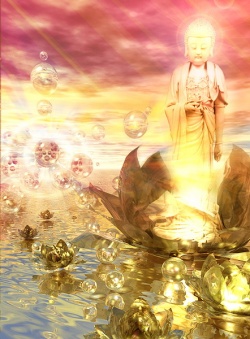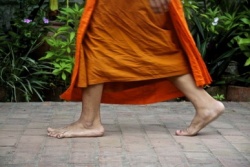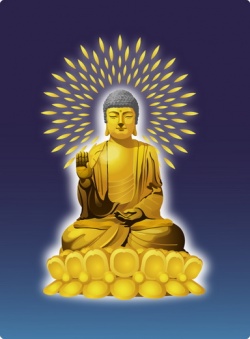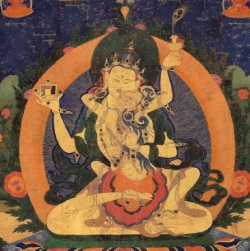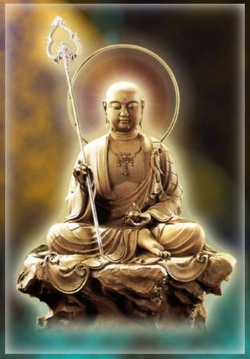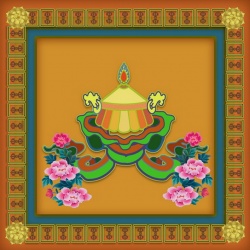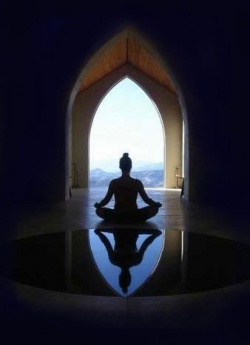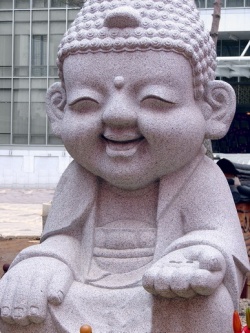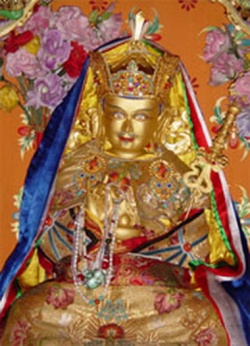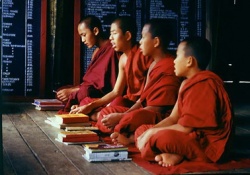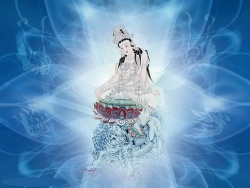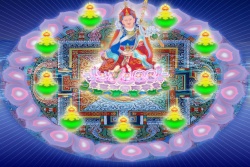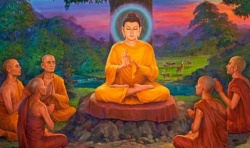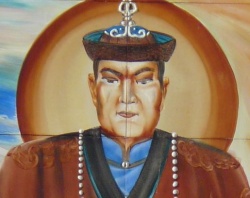Difference between revisions of "Native tradition in Korean Zen"
(Created page with " Native tradition in Korean Zen by Mu Soeng Sunim From a talk at Providence Zen Center in January, 1987 and first printed in Primary Point volume 6, number 1 (Ju...") |
|||
| (One intermediate revision by the same user not shown) | |||
| Line 1: | Line 1: | ||
| − | + | {{DisplayImages|52|2304|567|1941|59|4246|854|1355|654|1118|3026|1340|984|130|1541}}{{DisplayImages|4478|12|704|4485|485|4545}} | |
[[Native tradition in Korean Zen]] | [[Native tradition in Korean Zen]] | ||
by [[Mu Soeng Sunim]] | by [[Mu Soeng Sunim]] | ||
| Line 5: | Line 5: | ||
From a talk at [[Providence Zen Center]] in January, 1987 and first printed in Primary Point volume 6, number 1 (June 1989) and volume 6, number 2 (October 1989). | From a talk at [[Providence Zen Center]] in January, 1987 and first printed in Primary Point volume 6, number 1 (June 1989) and volume 6, number 2 (October 1989). | ||
| − | One time someone asked [[Zen Master]] [[Seung Sahn]] about the importance of the history of | + | One time someone asked [[Zen Master]] [[Seung Sahn]] about the importance of the [[history of Zen]], and he said, "[[Knowing]] the history of your [[tradition]] is like coming face to face with your {{Wiki|ancestors}}. These {{Wiki|ancestors}} are your [[roots]]; when you know these [[roots]], you also know something about yourself." So when one studies within a certain [[tradition]], it is a natural {{Wiki|curiosity}} to want to know about the [[roots]] of that [[tradition]], where the [[tradition]] has come from, and what are the sources of inspiration within that [[tradition]]. |
| + | |||
| + | This talk is primarily about the thirteenth-century [[monk]] [[Chinul]], who is the founder of the native [[tradition]] of [[Zen]] in [[Korea]]. But it is also, by necessity, a talk about the larger spectrum of {{Wiki|Chinese}} and [[Korean Zen traditions]]. One cannot really understand [[Chinul's]] impact on [[Korean Zen]] without [[knowing]] what went on in [[Korean Zen]] before him, and that cannot be understood without some [[understanding]] of [[Zen]] in [[China]]. | ||
| + | |||
| − | |||
[[Chinul]] is to [[Korean Zen]] what [[Hui-neng]] is to [[Chinese Zen]]. [[Hui-neng]] was not only the [[sixth patriarch]] in the line of succession from [[Bodhidharma]], but actually he was the real founder of [[Zen]] in [[China]]. There are four stages of [[development]] of the [[Zen tradition]] in [[China]]. Each of these stages is associated with a historical incident and points to a key ingredient of [[Zen]] practice. | [[Chinul]] is to [[Korean Zen]] what [[Hui-neng]] is to [[Chinese Zen]]. [[Hui-neng]] was not only the [[sixth patriarch]] in the line of succession from [[Bodhidharma]], but actually he was the real founder of [[Zen]] in [[China]]. There are four stages of [[development]] of the [[Zen tradition]] in [[China]]. Each of these stages is associated with a historical incident and points to a key ingredient of [[Zen]] practice. | ||
| − | The first was the arrival of [[Bodhidharma]] in [[China]]. He arrived at the court of [[Wikipedia:Emperor Wu of Liang|Emperor Wu]] and had an interview with him in which the [[Emperor]] enumerated the [[temples]] he had built, all the charities and the good works he had done. He then asked [[Bodhidharma]], "What do you think? What is the [[merit]] of all this?" [[Bodhidharma]], very coolly, said, "None whatsoever." This must have shocked the [[Emperor]] because the answer was so contrary to everything he believed. He then asked [[Bodhidharma]] several more questions, to which [[Bodhidharma]] gave equally unsatisfactory (to the [[Emperor]]) answers. Finally, in [[frustration]], the [[Emperor]] asked him, "Who are you?" (meaning, "Who are you to be giving me all these crazy answers?"). And [[Bodhidharma]] said, "I don't know," (or, "I have no [[idea]].") Obviously, after this exchange [[Bodhidharma]] was not very welcome at the [[Emperor's]] court, and he went off and sat in a {{Wiki|cave}} at [[Shaolin Temple]] for nine years. So, that is the first step in the [[tradition]] of [[Zen]] in [[China]] - the example of [[Bodhidharma]] sitting motionless and facing a blank wall. This is the way we sit even today in our [[dharma halls]]. | + | The first was the arrival of [[Bodhidharma]] in [[China]]. He arrived at the court of [[Wikipedia:Emperor Wu of Liang|Emperor Wu]] and had an interview with him in which the [[Emperor]] enumerated the [[temples]] he had built, all the charities and the good works he had done. He then asked [[Bodhidharma]], "What do you think? What is the [[merit]] of all this?" [[Bodhidharma]], very coolly, said, "None whatsoever." |
| + | |||
| + | |||
| + | This must have shocked the [[Emperor]] because the answer was so contrary to everything he believed. He then asked [[Bodhidharma]] several more questions, to which [[Bodhidharma]] gave equally unsatisfactory (to the [[Emperor]]) answers. Finally, in [[frustration]], the [[Emperor]] asked him, "Who are you?" (meaning, "Who are you to be giving me all these crazy answers?"). And [[Bodhidharma]] said, "I don't know," (or, "I have no [[idea]].") | ||
| + | |||
| + | Obviously, after this exchange [[Bodhidharma]] was not very welcome at the [[Emperor's]] court, and he went off and sat in a {{Wiki|cave}} at [[Shaolin Temple]] for nine years. So, that is the first step in the [[tradition]] of [[Zen]] in [[China]] - the example of [[Bodhidharma]] sitting motionless and facing a blank wall. This is the way we sit even today in our [[dharma halls]]. | ||
| + | |||
| + | |||
| + | The second step relates to [[Hui-neng]]. [[Hui-neng]] was a poor, fatherless boy who used to sell firewood in the marketplace so he could support himself and his mother. One day he heard a [[monk]] reciting a line from the [[Diamond Sutra]]; he was maybe thirteen years old at the time and when he heard the verse from the [[Diamond Sutra]], he got [[enlightened]] on the spot. This is the second step, the [[tradition]] of [[sudden enlightenment]]. | ||
| + | |||
| + | |||
| + | I will not get technical about [[sudden or gradual]] [[enlightenment]], but only know that, according to [[tradition]], if one's practice is mature enough and solid enough, [[enlightenment]] will happen all of a sudden. You never know the time or the place where it's going to happen or how long it will take to reach this [[state]]. Students of [[Zen]] practice in the {{Wiki|hope}} that this event will happen in their [[life]]. This is the inspiration from [[Hui-neng's]] [[life]]. | ||
| + | |||
| + | Up until the time of [[Hui-neng]], all the [[monks]] were reading the [[sutras]] and building [[temples]], hoping that all these [[good deeds]] would bring them [[merit]] in the next [[life]]. [[Hui-neng]] said that none of this was necessary to get [[enlightenment]]. He went even one more step and said that even [[meditation]] wasn't necessary. That was a very radical step in [[Chinese Zen]]. | ||
| + | |||
| + | |||
| + | [[Hui-neng]] never explained how to get to this [[state of enlightenment]] but our [[own]] [[teacher]], [[Zen Master]] [[Seung Sahn]], goes all over the [[world]] and talks only about this "don't know" [[mind]]. He keeps saying over and over again that if you keep this don't know [[mind]] one hundred percent at all times, then you are already [[enlightened]]. | ||
| + | |||
| + | So, if you keep a don't know [[mind]] at all times and all places, then sitting [[meditation]] is not necessary. This is a direct connection between [[Zen Master]] [[Seung Sahn's]] [[teaching]] and [[Hui-neng's]] [[teaching]]. Later in this article when [[Chinul]] and [[Korean Zen]] are discussed, it will be seen that [[Chinul]] is also talking about one [[moment]] of [[effort]] - this [[moment]] of [[effort]] - and that's all it takes. | ||
| + | |||
| + | |||
| + | The third step that took place in the history of [[Chinese Zen]] is associated with the [[patriarch]] [[Ma-tsu]], who was the second generation successor of [[Hui-neng]]. [[Ma-tsu]] invented the [[shock]] tactics of suddenly shouting at a questioner, hitting the questioner, or suddenly calling out the questioner's [[name]] as he was about to leave the room. [[Ma-tsu]] was a true innovator in this regard; he wanted to break through all the {{Wiki|conceptual}} [[thinking]] we have. | ||
| + | |||
| + | [[Hui-neng]] talked about arriving at this point but he never talked about how you arrive there. It was left to [[Ma-tsu]] to invent all those tactics of sudden [[shock]] which jar your [[consciousness]] and make a [[breakthrough]]. | ||
| + | |||
| + | The fourth step was the compete systematization of the [[kong-an]] system. [[Ma-tsu]] and his successors were very gifted [[teachers]]. Some of his successors also had relatively few students, so they could have personal encounters with their students and be creative enough and [[skillful]] enough to bring the [[student]] to [[enlightenment]] through a [[shock]] {{Wiki|tactic}}. | ||
| + | |||
| + | This was the Golden Age of [[Zen]], approximately from 700-900 A.D. However, as the number of students grew, personal instruction became very difficult. So, the [[Zen master]] used the stories of the old [[Zen]] [[masters]] to teach their [[own]] students. In Sung [[China]] (tenth century A.D.), this system was perfected and most effectively used by [[Zen master]] [[Ta-hui]]. | ||
| + | |||
| + | |||
| + | |||
| + | Before [[Hui-neng]], [[Zen]] (or [[Ch'an]]) had flourished in northern [[China]]. [[Bodhidharma]] had stayed at [[Shaolin temple]] and his successors were [[monks]] from the northern part of the country. That's where they had their [[temples]] and some {{Wiki|patronage}} from the {{Wiki|royal court}}. In fact, until [[Hui-neng]], [[Ch'an]] was just one of the many competing [[Buddhist]] sects in northern [[China]]. | ||
| + | |||
| + | The story of [[Hui-neng's]] [[transmission]] is quite well-known so it need not be repeated here, but when [[Hui-neng]] had to flee his [[teacher's]] [[temple]] after receiving the secret [[transmission]], he crossed the {{Wiki|Yangtze River}} and traveled as far [[south]] as the present-day [[Canton]]. | ||
| + | |||
| + | When he finally established his [[temple]] in this extreme southern part of [[China]], a new kind of [[Zen]] appeared: it was rural and centered around a {{Wiki|community}} of {{Wiki|farming}} [[monks]]. | ||
| + | |||
| + | [[Northern Ch'an]] had relied on the [[sutras]], on building [[temples]], and {{Wiki|patronage}} of the {{Wiki|royal court}}, but Southern [[Ch'an]] was economically self-reliant and revolved around the work [[ethic]]. | ||
| + | |||
| + | The [[monks]] farmed the [[monastery]] land during daytime, didn't read any [[sutras]], didn't even have a [[meditation]] hall or practice any formal [[meditation]]. They kept their practice alive in the midst of doing [[physical]] labor throughout the day. | ||
| + | |||
| + | When [[Zen]] appeared in [[Korea]], it was a direct successor of southern [[Ch'an]]. During the period from 828 to 935, there appeared the so-called Nine Mountain Schools of [[Zen]]. | ||
| + | |||
| + | These [[temples]] and their {{Wiki|ethos}} were a mirror-reflection of what was happening in [[Chinese Zen]] at the same time. The marvelous thing about these [[nine schools]] is that seven of these schools were started by [[Korean]] [[monks]] who were students of [[Ma-tsu's]] successors. | ||
| + | |||
| + | |||
| + | [[Ma-tsu]] is a very [[interesting]] figure in the history of [[Zen]]. In a comparison to American history, it would seem that [[Bodhidharma]] is like George {{Wiki|Washington}}, and [[Hui-neng]] is [[Zen's]] [[Thomas Jefferson]]. | ||
| + | |||
| + | [[Ma-tsu]] is more like [[Theodore Roosevelt]], the rider on horseback. He was the greatest [[Zen]] [[teacher]] of his time and it is said that there were, at times, as many as eight hundred [[monks]] in his [[monastery]]. He gave [[transmission]] to one hundred and thirty-nine [[dharma]] successors, and is known to history as the Great [[Patriarch]]. | ||
| + | |||
| + | Among these one hundred and thirty-nine successors were some of the most influential [[teachers]] in [[Zen]] history. One was [[Pai-chang]], who formed the [[monastic rules]] that we follow even today, and whose successor, [[Huang-po]], was the [[teacher]] of the famous [[Lin-chi]]. | ||
| + | |||
| + | |||
| + | The second was [[Nan-chuan]] ([[Korean]]:[[ Nam Cheon]]), perhaps the most brilliant of [[Ma-tsu's]] students, and the [[teacher]] of [[Chao-chou]] ([[Korean]]: [[Joju]]). The third of these [[teachers]] is not quite so well-remembered in history; his [[name]] was [[Shi-tang Chi-tsang]]. | ||
| + | |||
| + | Three of the founders of the [[Nine Mountain Schools]] in [[Korea]] were students of [[Shi-tang Chi-tsang]], one was a [[student]] of [[Nam Cheon]] and three were students of [[Ma-tsu's]] immediate successors. | ||
| + | |||
| + | |||
| + | Thus our [[lineage]] is from [[Ma-tsu]] and from [[Hui-neng]], and this is the [[tradition]] of [[Korean Zen]]. [[Korean Zen]] is also called [[Chogye Zen]], after the [[name]] of the [[temple]] of [[Hui-neng]] in [[south]] [[China]]. [[Zen Master]] [[Seung Sahn]] is the seventy-eighth [[patriarch]] in his particular line of succession that starts with the [[Buddha]] and continues through [[Hui-neng]] and [[Ma-tsu]]. | ||
| − | + | When the [[Nine Mountain Schools]] of [[Zen]] appeared in [[Korea]] in the ninth century, they modeled themselves along the same lines as the [[temples]] of [[Ma-tsu's]] successors, that is [[temples]] in the [[mountains]] with the [[monks]] working the farm land around the [[monastery]] and being economically self-reliant. However, the [[development]] of [[Zen]] in [[Korea]] differed in one significant aspect from [[Zen]] in [[China]] or [[Japan]]. | |
| − | |||
| − | |||
| − | + | In [[China]] and [[Japan]], [[Zen]] always had a special place of its [[own]]; it was autonomous and quite {{Wiki|independent}} of [[Buddhism]]. But that never happened in [[Korea]] for a number of [[reasons]]: [[Korea]] is and was a very small country; it had a period of civil [[war]] that lasted for about a hundred years in the fifth and sixth centuries; and [[Buddhism]] played a very large part in the formation of the [[United Silla Kingdom]] in 668 A.D. | |
| − | + | [[Buddhism]] played the role of a [[state]] [[religion]], and was protected and patronized by the rulers. So, when the new branch of [[Buddhism]] called [[Zen]] appeared in the ninth century, instead of having time to develop its [[own]] system and {{Wiki|institutions}}, it was immediately absorbed into {{Wiki|mainstream}} [[Buddhism]] and received the same {{Wiki|patronage}} from the {{Wiki|royal court}} as other schools. | |
| − | |||
| − | + | Thus within a hundred years of the founding of [[Nine Mountain Schools of Zen]], we find that [[Zen]] in [[Korea]] cannot be {{Wiki|distinguished}} from the other schools - [[Zen]] [[monks]] wore the same fancy [[robes]], lived in fancy [[temples]], enjoyed all the riches of [[food]], and had access to the power centered at the {{Wiki|royal court}}. The {{Wiki|royal court}} instituted a system of exams for [[Zen]] [[monks]] corresponding to similar exams for other [[Buddhist monks]]. | |
| − | |||
| − | + | This was one way for the [[state]] to have control over the shape and [[development]] of [[Zen]]. [[Traditionally]], [[Zen monks]] were always found sitting in [[meditation]] in mountain [[temples]], but now, here were many [[monks]] living in the city [[temples]] and spending three years memorizing the [[sutras]] and other texts. Thus, within a short time, [[Zen]] lost all its [[vitality]] and drive. | |
| − | |||
| − | + | In the tenth and eleventh centuries [[Korea]] [[suffered]] a series of attacks from the [[north]] by {{Wiki|Mongolian}} tribes, most especially the [[Khitans]]. | |
| − | + | There was never any [[peace]] in [[Korea]] during this time, and as a result of these [[conditions]], both the affairs of [[state]] and [[religion]] fell into disorder. This was the situation of [[Buddhism]] in [[Korea]] in the [[latter]] half of the twelfth century, when [[Zen Master]] [[Chinul]] appeared on the scene. | |
| − | [[Chinul]] was born in 1158 A.D. This was a very [[interesting]] time for [[Buddhism]] in {{Wiki|East Asia}} | + | [[Chinul]] was born in 1158 A.D. This was a very [[interesting]] time for [[Buddhism]] in {{Wiki|East Asia}}. |
| − | + | [[Zen Master]] [[Ta-hui]], who was mentioned before and who perfected the system of [[kong-an practice]] in [[China]], was only one generation removed from [[Chinul]]. As a {{Wiki|matter}} of fact, [[Ta-hui]] [[died]] in 1163, five years after [[Chinul]] was born. | |
| − | This was a staggering blow to [[Buddhism in China]], one from which it has never quite recovered. One of the ironic effects of this persecution was that while [[Buddhism]] was wiped out in northern [[China]], [[Zen]] in [[south]] [[China]] was relatively unaffected. Southern [[Ch'an]] was not a player in the power games at the {{Wiki|royal court}}, and they didn't have [[temples]] with large [[statues]] of the [[Buddha]] with {{Wiki|gold}} and [[precious]] stones. In northern [[China]], when the [[temples]] were destroyed, the [[statues]] made out of bronze and {{Wiki|copper}} were melted down and used for making coins. The [[monks]] of southern [[Ch'an]] didn't even read [[sutras]] and lived the simple [[life]] of a {{Wiki|farming}} {{Wiki|community}}, so they didn't have any possessions that could be taken away. They didn't have a high profile and so they didn't have much to lose in the persecution. | + | |
| + | Also, at a time when [[Chinul]] was trying to sow the [[seeds]] of a native [[tradition]] in [[Korea]], [[Zen]] was brought from [[China]] to [[Japan]], where [[Zen Master]] [[Dogen]] became one of its great exponents. By the year 1200, [[Zen]] had largely disappeared in [[China]] but there was a new flowering in [[Korea]] and [[Japan]]. | ||
| + | |||
| + | But, why did [[Zen]] [[die]] out in [[China]]? First of all, there was a severe [[repression of Buddhism in China]] in 845. [[Buddhism]] had originally appeared in [[China]] in the first century A.D. and it supplanted [[Taoism]] and [[Wikipedia:Confucianism|Confucianism]] as the [[state]] [[religion]] for [[China's]] dynasties over many centuries. | ||
| + | |||
| + | |||
| + | [[Buddhism]] gained a lot of economic and {{Wiki|political}} power at the expense of [[Taoists]] and [[Confucianists]], so, all this time, they were conspiring against [[Buddhism]], trying to find ways to bring it down. In 845, [[Wikipedia:Emperor Wu of Liang|Emperor Wu]] came to power and he called himself a [[Wikipedia:Taoism|Taoist]]. For two years from 845 to 847 there was extremely severe persecution of [[Buddhists]]. | ||
| + | |||
| + | The statistics of this repression are quite remarkable: two hundred and sixty thousand [[monks and nuns]] were forced to give up their [[robes]]; forty-eight hundred major [[monasteries]] and [[temples]] were destroyed. | ||
| + | |||
| + | |||
| + | This was a staggering blow to [[Buddhism in China]], one from which it has never quite recovered. One of the ironic effects of this persecution was that while [[Buddhism]] was wiped out in northern [[China]], [[Zen]] in [[south]] [[China]] was relatively unaffected. | ||
| + | |||
| + | Southern [[Ch'an]] was not a player in the power games at the {{Wiki|royal court}}, and they didn't have [[temples]] with large [[statues]] of the [[Buddha]] with {{Wiki|gold}} and [[precious]] stones. In northern [[China]], when the [[temples]] were destroyed, the [[statues]] made out of bronze and {{Wiki|copper}} were melted down and used for making coins. | ||
| + | |||
| + | |||
| + | |||
| + | The [[monks]] of southern [[Ch'an]] didn't even read [[sutras]] and lived the simple [[life]] of a {{Wiki|farming}} {{Wiki|community}}, so they didn't have any possessions that could be taken away. They didn't have a high profile and so they didn't have much to lose in the persecution. | ||
When the [[Sung dynasty]] came to power in 960 in northern [[China]], the only [[form]] of [[Buddhism]] that was left in the country was the southern [[Ch'an]]. The Sung [[emperors]] made it their house [[religion]], and as a result, it too became corrupt and lost its [[vitality]]. [[Zen Master]] [[Ta-hui]] was the last major figure to infuse any [[vitality]] into the system; once he was gone, there was no [[teacher]] of his stature to sustain it. | When the [[Sung dynasty]] came to power in 960 in northern [[China]], the only [[form]] of [[Buddhism]] that was left in the country was the southern [[Ch'an]]. The Sung [[emperors]] made it their house [[religion]], and as a result, it too became corrupt and lost its [[vitality]]. [[Zen Master]] [[Ta-hui]] was the last major figure to infuse any [[vitality]] into the system; once he was gone, there was no [[teacher]] of his stature to sustain it. | ||
| + | |||
Returning to [[Chinul]], one finds that he was a sickly child. His [[parents]] prayed to the [[Buddha]] and [[vowed]] that if he recovered they would allow him to become a [[monk]]. He did recover, and had his head shaved at the age of six or seven. This is a very graphic example of how [[Buddhism]] benefited as a [[state]] [[religion]] in {{Wiki|East Asia}} - [[Buddhism]] was an all-permeating [[religion]] with strange [[beliefs]] and {{Wiki|superstitions}} far removed from the teachings of the [[historical Buddha]]. This happened to many children and [[Chinul]] was by no means unique in this [[respect]]. | Returning to [[Chinul]], one finds that he was a sickly child. His [[parents]] prayed to the [[Buddha]] and [[vowed]] that if he recovered they would allow him to become a [[monk]]. He did recover, and had his head shaved at the age of six or seven. This is a very graphic example of how [[Buddhism]] benefited as a [[state]] [[religion]] in {{Wiki|East Asia}} - [[Buddhism]] was an all-permeating [[religion]] with strange [[beliefs]] and {{Wiki|superstitions}} far removed from the teachings of the [[historical Buddha]]. This happened to many children and [[Chinul]] was by no means unique in this [[respect]]. | ||
| − | At the age of fifteen, [[Chinul]] went to live in a [[temple]] and took the formal [[precepts]] of a [[novice monk]]. One [[interesting]] fact about Chinul's [[life]] is that he never had a formal [[teacher]], one who may have guided his [[intellectual]] or [[spiritual]] [[development]]. He had a [[preceptor]], like any other [[Buddhist monk]], but he always studied on his [[own]]. His [[self-study]] program was quite remarkable and innovative for a [[monk]] of his time, for he combined his study of [[sutras]] with [[Zen]] practice. | + | At the age of fifteen, [[Chinul]] went to live in a [[temple]] and took the formal [[precepts]] of a [[novice monk]]. One [[interesting]] fact about [[Chinul's]] [[life]] is that he never had a formal [[teacher]], one who may have guided his [[intellectual]] or [[spiritual]] [[development]]. |
| + | |||
| + | |||
| + | He had a [[preceptor]], like any other [[Buddhist monk]], but he always studied on his [[own]]. His [[self-study]] program was quite remarkable and innovative for a [[monk]] of his time, for he combined his study of [[sutras]] with [[Zen]] practice. | ||
| + | |||
| + | |||
| + | Ever since the arrival of [[Zen]] in [[Korea]] with the establishment of the [[Nine Mountain Schools]], there was a fierce rivalry between [[Zen]] and the [[sutra]] schools and neither wanted to have anything to do with the other. | ||
| + | |||
| + | The [[sutra]] schools insisted on studying the [[sutras]] for twenty or thirty years, and gradually becoming a [[Buddha]]. The [[Zen]] schools started with the premise that you are already a [[Buddha]] and all you have to do is to rediscover that through personal [[meditation]]. | ||
| + | |||
| + | Thus studying the [[sutras]] is quite irrelevant. [[Chinul]] became the first thinker in [[Korean]] [[Buddhist]] history to effectively resolve this conflict between the two approaches, and it was resolved in his [[own]] [[experience]]. | ||
| + | |||
| + | |||
| + | [[Chinul]] had three major awakenings or [[enlightenment experiences]] in his [[life]]. The first one was when he read the [[Platform Sutra]] of the [[sixth patriarch]] ([[Hui-neng]]). The second [[awakening]] was when he read the [[Avatamsaka Sutra]] and the third was when he read the Records of [[Zen Master]] [[Ta-hui]]. | ||
| − | + | Two of these documents, the [[Platform Sutra]] and the Record of [[Ta-hui]], are classic statements of [[Zen tradition]], whereas the [[Avatamsaka Sutra]] is the basic document of the [[Jua-yen]] ([[Korean]]: [[Hwa-om]]) School, which was the most [[influential sutra school]] in [[Korea]]. | |
| − | |||
| − | + | Thus, throughout his [[life]], [[Chinul]] emphasized simultaneous [[cultivation]] of both [[doctrinal]] [[understanding]] and personal practice. | |
| − | + | At the age of twenty-two, [[Chinul]] came to the {{Wiki|capital city}} to take his [[monk's]] exams, but was dismayed to see all his fellow [[monks]] struggling for [[fame]] and power. | |
| − | + | They all wanted to pass the exam and get a position at the {{Wiki|royal court}} with prestige and influence. As a {{Wiki|reaction}} to this jockeying for power, he wrote a manifesto urging his fellow [[monks]] to leave this [[worldly]] struggle and [[retreat]] into the [[mountains]] to [[form]] a practicing {{Wiki|community}}. | |
| − | |||
| − | |||
| − | [[ | + | He was able to have ten other [[monks]] sign this manifesto and they decided to meet together at some time in the {{Wiki|future}} and start the {{Wiki|community}} with they proposed to call {{Wiki|Jung}} [[Hae Sa]] or "[[Samadhi]] and [[Prajna]] {{Wiki|Community}}." [[Samadhi]] means [[meditation practice]] and [[prajna]] means [[wisdom]] or [[intuitive understanding]]. |
| − | + | It is a tribute to [[Chinul's]] influence that today there are at least fifteen [[temples]] in [[Korea]] that call themselves [[Jung Hae Sa]]. Our [[own]] [[lineage]] comes from [[Su Dok Sa]] [[temple]] on [[Duk Sung]] mountain, where one of the major [[temples]] is [[Jung Hae Sa]]. | |
| − | + | This [[temple]] was established by [[Zen Master]] [[Man Gong]] in the early 1930's for the {{Wiki|training}} of his senior students. | |
| − | |||
| − | |||
| − | [[Chinul]] was asked, "When the [[true mind]] is beset by [[delusion]], it becomes an [[ordinary mind]]. How then can we escape from [[delusion]] and achieve sanctity?" He replied, "When there is no place for the | + | [[Zen Master]] [[Seung Sahn]] calls this [[Jung Hae Sa]] the primary point of our [[lineage]]; so, [[Jung Hae Sa]] of our school and the [[Jung Hae Sa]] {{Wiki|community}} that [[Chinul]] founded have the same focus. |
| + | |||
| + | At this point, it is useful to note some remarkable parallels between the [[lives]] of [[Dogen]] and [[Chinul]]. They were near-contemporaries, [[Chinul]] being older. | ||
| + | |||
| + | They were both dismayed by the struggle for [[fame]] and power at the {{Wiki|royal court}} and went into the [[mountains]] to establish their communities of [[monks]]. They both dedicated their [[lives]] to intensive practice and lived very [[pure]] and simple [[lives]]. | ||
| + | |||
| + | There is nothing dramatic in the [[lives]] of either [[Dogen]] or [[Chinul]]. They both had a very strong [[direction]] in their [[life]] and dedicated their entire [[energy]] to following that [[direction]]. | ||
| + | |||
| + | It is not an accident that [[Dogen]] is considered the most original thinker in [[Japanese]] [[religious]] history and [[Chinul]] occupies the same lofty position within the [[Korean]] [[religious]] [[tradition]]. | ||
| + | |||
| + | |||
| + | It is [[interesting]] to note that {{Wiki|Thomas Aquinas}} appeared in {{Wiki|Europe}} at approximately the same time, roughly after [[Dogen]], and became the fountainhead of all subsequent [[Christian]] {{Wiki|theological}} [[thinking]]. Thus, within a period of fifty years, these three original [[religious]] thinkers appeared in different parts of the [[world]], and shaped their [[traditions]] in such a way that their influence is felt even today. | ||
| + | |||
| + | When [[Chinul]] did not hear from his fellow [[monks]] who had signed the [[Jung Hae Sa]] manifesto within the agreed time, he went traveling and lived in a [[temple]] in the [[southwest]] corner of [[Korea]]. | ||
| + | |||
| + | There is speculation that he chose to live in this part of the country because this was the only area of [[Korea]] to have any maritime contacts with [[China]]. As a result of [[Khitan]] invasions in the [[north]], | ||
| + | |||
| + | |||
| + | [[Korea]] did not enjoy any diplomatic or overland trade relations with [[China]]. | ||
| + | |||
| + | The port towns along the {{Wiki|western}} coasts of [[Korea]] were the only places where {{Wiki|merchants}} could carry on any kind of trade with [[China]]. | ||
| + | |||
| + | It is possible that [[Chinul]] may have hoped to get hold of some news of [[Buddhist]] [[activities]] in [[China]] through these {{Wiki|merchants}}. However, he never went to [[China]]. | ||
| + | |||
| + | It is also [[interesting]] to note that two of the greatest thinkers in [[Korean]] [[Buddhist]] history, [[Won Hyo]] and [[Chinul]], never went to [[China]], although it was quite common, even obligatory for [[Korean]] [[monks]] to go to [[China]], study under a [[great teacher]], and come back to establish their [[own]] [[temple]]. | ||
| + | |||
| + | |||
| + | |||
| + | [[Won Hyo]] and [[Chinul]] never made it. But [[Chinul]] did come into possession of [[Ta-hui's]] writings during his stay in the [[southwest]] and these writings were a lifelong influence on his [[thinking]]. | ||
| + | |||
| + | [[Zen Master]] [[Chinul]] became the [[first Zen teacher in Korea]] to systematically use [[hwa-tou]] ([[kong-an]]) practice in the {{Wiki|training}} of [[monks]] in his {{Wiki|community}}. | ||
| + | |||
| + | This was also an [[interesting]] transitional time in [[Korean Zen]]. The founders of the [[Nine Mountain Schools]] had trained in [[Ma-tsu's]] method of [[shock]] tactics, but even in [[China]] itself, the use of [[kong-ans]] as a [[teaching]] tool was not adopted until the third generation after [[Zen Master]] [[Lin-chi]] in the mid-tenth century. | ||
| + | |||
| + | By that time, it had become very difficult for [[Korean]] [[monks]] to travel to [[China]]; also, [[Korean Zen]] itself had lost its original [[vigor]] and was entering a period of {{Wiki|decline}}. For these [[reasons]], it fell to [[Chinul]] to introduce this new [[teaching]] tool in [[Korean Zen]]. | ||
| + | |||
| + | His [[own]] [[knowledge]] of it came through the writings of [[Zen Master]] [[Tai-hui]] (1089-1163). | ||
| + | |||
| + | |||
| + | Before we go into [[Chinul's]] method of investigating the [[hwa-tou]], I want to {{Wiki|emphasize}} [[Chinul's]] insistence again and again on "[[one mind]]." This is the core of [[Chinul's]] [[teaching]]: | ||
| + | |||
| + | that both the [[deluded mind]] and the [[enlightened mind]] are part of the same landscape, the [[one mind]]. | ||
| + | |||
| + | The [[deluded mind]] is not separate from the [[enlightened one]] and the [[enlightened mind]] is not separate from the [[deluded mind]], and they are both within us. Most of us have the [[idea]] that there is something outside of us that we must look for. | ||
| + | |||
| + | [[Chinul]] firmly demolishes this notion again and again in his writings and talks. For a record of [[Chinul's]] writings, we have a translation of [[Chinul's]] works by [[Robert Buswell]] ([[The Korean Approach to Zen]], {{Wiki|University of Hawaii Press}}, Honolulu), a premier work of [[Buddhist]] {{Wiki|scholarship}} in {{Wiki|America}}. | ||
| + | |||
| + | |||
| + | In [[Buswell's]] translation, [[Chinul's]] [[writing]] is very clear; part of the [[reason]] is the writings are answers to questions put to him in open assemblies. Thus his words become live and have a [[sense]] of {{Wiki|immediacy}} about them. | ||
| + | |||
| + | At an assembly, someone asked [[Chinul]], "How is it that [[saints]] and [[ordinary people]] are not the same?" We all have this [[idea]] that we are very ordinary and are not [[saints]], that we are {{Wiki|inferior}}, that we don't have the qualities of [[saints]]. | ||
| + | |||
| + | The questioner is asking [[Chinul]] why, if both the [[ordinary person]] and the [[saint]] have the same one [[mind]], they are not the same? [[Chinul]] responded to this question, | ||
| + | |||
| + | "The [[true mind]] is originally the same in the [[saint]] and the [[ordinary man]], but because the [[ordinary man]] endorses the [[reality]] of material things with the false [[mind]], he loses his [[pure]] [[nature]] and becomes estranged from it, therefore the [[true mind]] cannot appear. It is like the tree's shadow in the {{Wiki|darkness}}, or a spring flowing underground. It [[exists]]." | ||
| + | |||
| + | |||
| + | [[Chinul]] was asked, "When the [[true mind]] is beset by [[delusion]], it becomes an [[ordinary mind]]. How then can we escape from [[delusion]] and achieve sanctity?" He replied, "When there is no place for the [[deluded mind]], that is [[bodhi]]. [[Samsara and nirvana]] always remain {{Wiki|equal}}." It becomes a very [[interesting]] question: how can we reach this place where the deluded [[mind]] has no place? | ||
| + | |||
| + | [[Chinul]] describes this place as "[[luminous awareness]]." Later on, someone asked him how we approach this place and, in response, we have an [[interesting]] exchange: | ||
| − | |||
<poem> | <poem> | ||
[[Chinul]]: Do you hear the [[sound]] of the [[crow]] cawing? That magpie calling? | [[Chinul]]: Do you hear the [[sound]] of the [[crow]] cawing? That magpie calling? | ||
| Line 83: | Line 222: | ||
[[Chinul]]: Trace him back and listen to your hearing [[nature]]. Do you hear any {{Wiki|sounds}}? | [[Chinul]]: Trace him back and listen to your hearing [[nature]]. Do you hear any {{Wiki|sounds}}? | ||
</poem> | </poem> | ||
| − | |||
| − | |||
| − | When [[Chinul]] is talking about entering into the [[sound]], the same can be applied to [[tasting]], [[seeing]], [[touching]], everything. In "just doing it" one hundred percent, there is no {{Wiki|discrimination}}. So, the [[student]] says, at that point the {{Wiki|sounds}} and {{Wiki|discrimination}} do not obtain. [[Chinul]] says, "Marvelous! Marvelous! This is [[Avalokitesvara's]] method for entering the {{Wiki|noumenon}}. Let me ask you again. You said that {{Wiki|sounds}} and discriminations do not obtain at that place. But since they do not obtain, isn't the hearing-nature just [[empty space]] at such a time?" The [[student]] says, "Originally, it is not [[empty]], it is always bright and never obscured." [[Chinul]] asks again, "What is this [[essence]] which is not [[empty]]?" The [[student]]: "As it has no former shape, words cannot describe it." | + | This is an [[interesting]] experiment all of us can do. Anytime we hear a [[sound]], whether it is the [[sound]] of a jet plane overhead or a bird singing outside, all we have to do is bring this [[sound]] inside and listen one hundred percent. If we listen one hundred percent, there is no [[idea]] of "I am listening to the [[sound]]." |
| + | |||
| + | So when [[Chinul]] asked the [[student]] what happens when you listen to the [[sound]] of a [[crow]] or the magpie, one hundred percent, the [[student]] said, "At that place {{Wiki|sounds}} and discriminations do not obtain." That can be our [[experience]], too. If we really go deep into a [[sound]], the [[idea]] of "I am listening to a [[sound]]" disappears; then you become the [[sound]]. | ||
| + | |||
| + | Sometimes at [[Zen]] centers this happens - we are listening to the morning [[bell]] [[chant]], being a little sleepy, not completely asleep but just a little bit, and the [[bell]] is hit. All of a sudden, there is nothing but the [[sound]] of the [[bell]] resonating deep within ourselves. Then, there is no [[sound]] and no {{Wiki|discrimination}}. "I, my, me" disappears and the whole [[universe]] is just one [[sound]]. | ||
| + | |||
| + | |||
| + | This place of no {{Wiki|discrimination}} is what [[Chinul]] calls {{Wiki|luminous}} [[awareness]]. This is the whole point of [[Zen]] practice. [[Zen Master]] [[Seung Sahn]] always talks about cutting off I, my, me [[mind]]. Our [[mind]] is deluded because in every situation we apply I, my, me to everything that appears. When we don't see things through I, my, me, then we can see, hear, {{Wiki|taste}}, and {{Wiki|touch}} everything clearly. It's that simple. | ||
| + | |||
| + | When [[Chinul]] is talking about entering into the [[sound]], the same can be applied to [[tasting]], [[seeing]], [[touching]], everything. In "just doing it" one hundred percent, there is no {{Wiki|discrimination}}. So, the [[student]] says, at that point the {{Wiki|sounds}} and {{Wiki|discrimination}} do not obtain. [[Chinul]] says, "Marvelous! Marvelous! This is [[Avalokitesvara's]] method for entering the {{Wiki|noumenon}}. | ||
| + | |||
| + | Let me ask you again. You said that {{Wiki|sounds}} and discriminations do not obtain at that place. But since they do not obtain, isn't the hearing-nature just [[empty space]] at such a time?" The [[student]] says, "Originally, it is not [[empty]], it is always bright and never obscured." [[Chinul]] asks again, "What is this [[essence]] which is not [[empty]]?" The [[student]]: "As it has no former shape, words cannot describe it." | ||
| − | |||
| − | [[ | + | The [[student]] describes the hearing-nature as being always bright and never obscured. We can find the same thing in our [[own]] [[experience]] by bringing any [[sound]] within ourselves and going deep into our hearing-nature. You will find that there is something there, some kind of radiance; |
| − | + | it's not just blankness. This radiance or [[brightness]] is our [[luminous awareness]]. This [[brightness]] does not come from the {{Wiki|sun}}, it's our own [[original true nature]]. This [[experience]] can be reached through our [[eye-consciousness,]] [[nose-consciousness]], [[tongue-consciousness]], [[touch-consciousness]], and [[thinking-consciousness]]. | |
| − | In his writings, [[Chinul]] comes back to this issue again and again. And he gives some [[interesting]] examples. One of the examples he is fond of quoting many times is that of a frozen pond. "Although we know that the frozen pond is entirely [[water]], the sun's heat is necessary to melt it. Although we [[awaken]] to the fact that an [[ordinary man]] is [[Buddha]], the power of [[dharma]] is necessary to permeate our [[cultivation]]. When the pond is melted, the [[water]] flows freely and can be used for irrigation and cleaning. When falsities are [[extinguished]], the [[mind]] will be {{Wiki|luminous}} and dynamic, and then its function of penetrating [[brightness]] will [[manifest]]." | + | [[Chinul]] further says, "If you believe me to the point where you can suddenly extinguish your [[doubt]], show the will of a great man, and give rise to [[Wikipedia:Authenticity|authentic]] [[vision]] and [[understanding]]; if you know its {{Wiki|taste}} for yourself, arrive at the stage of self-affirmation, and gain [[understanding]] of your [[true nature]], then this is the [[understanding]] [[awakening]] achieved by those who have cultivated the [[mind]]. |
| + | |||
| + | |||
| + | |||
| + | Since no further steps are involved, it is called sudden. Therefore, it is said, 'When in the [[cause]] of [[faith]], one meshes without the slightest [[degree]] of error with all the qualities of the [[fruition]] of [[Buddhahood]], [[faith]] is achieved.'" | ||
| + | |||
| + | [[Chinul]] is asking us to show the will of a great [[person]] and have this complete [[faith]]. That's all we have to do: apply this resolution and [[courage]] to every situation that appears for us. Rather than holding onto our [[idea]] and applying I, my, me [[mind]] to every situation, we can let go and {{Wiki|perceive}} things as they really are. It's a simple {{Wiki|matter}} of whether a situation controls us or we control the situation. | ||
| + | |||
| + | Who is in control? By control, I don't mean in a neurotic [[sense]], but perceiving things with complete clarity and acting clearly. This is the [[mind]] of a [[saint]]. But if a situation clouds our [[vision]], we act with the [[mind]] of a [[deluded person]]. The choice is ours; we have the one [[mind]] from which comes the [[action]] of a [[saint]] or an [[ordinary man]]. | ||
| + | |||
| + | |||
| + | In his writings, [[Chinul]] comes back to this issue again and again. And he gives some [[interesting]] examples. One of the examples he is fond of quoting many times is that of a frozen pond. | ||
| + | |||
| + | "Although we know that the frozen pond is entirely [[water]], the sun's heat is necessary to melt it. Although we [[awaken]] to the fact that an [[ordinary man]] is [[Buddha]], the power of [[dharma]] is necessary to permeate our [[cultivation]]. | ||
| + | |||
| + | When the pond is melted, the [[water]] flows freely and can be used for irrigation and cleaning. When falsities are [[extinguished]], the [[mind]] will be {{Wiki|luminous}} and dynamic, and then its function of penetrating [[brightness]] will [[manifest]]." | ||
In our day-to-day [[life]], our [[mind]] is like a frozen pond, frozen by our {{Wiki|conditioning}} so that we respond in deluded ways and continue to wander around in the [[samsara]] of [[anger]], [[desire]], and [[ignorance]]. But when we start to practice, it's like the sun's heat; it comes down and melts the ice. The only thing that happens through practice is that the frozen waters of our {{Wiki|conditioning}} melt and start to flow. | In our day-to-day [[life]], our [[mind]] is like a frozen pond, frozen by our {{Wiki|conditioning}} so that we respond in deluded ways and continue to wander around in the [[samsara]] of [[anger]], [[desire]], and [[ignorance]]. But when we start to practice, it's like the sun's heat; it comes down and melts the ice. The only thing that happens through practice is that the frozen waters of our {{Wiki|conditioning}} melt and start to flow. | ||
| − | |||
| − | [[Chinul]] goes on to say, "[[Sentient beings]] are those who are deluded in regard to the one [[mind]], and give rise to [[boundless]] [[defilements]]. [[Buddhas]] are those who have [[awakened]] to the one [[mind]] and have given rise to the [[boundless]] [[sublime]] functions. Although there is a difference between [[delusion]] and [[awakening]], [[essentially]] both are derived from the one [[mind]]. Hence, to seek [[Buddhahood]] apart from the (deluded) [[mind]] is impossible." It is a remarkable statement for [[Korean Zen]] of the twelfth century, because at that time the whole notion of [[Buddhism]] was filled with the [[idea]] that the [[Buddhahood]] is something out there, maybe in the [[Pure Land]], and that you had to do these [[rituals]] or read these [[sutras]] and then maybe someday you will become [[Buddha]]. But [[Chinul]] says again and again, that to seek [[Buddhahood]] apart from the [[mind]] is impossible. | + | At another point, [[Chinul]] says, "A [[person]] who falls to the ground gets back up by using that ground. To try to get up without relying on that ground would be impossible." We all have the same {{Wiki|dilemma}}: how to let go of the {{Wiki|conditioning}} of [[anger]], [[desire]], and [[ignorance]]. |
| + | |||
| + | [[Chinul]] says we have to use our [[own]] deluded [[mind]] to get out of its [[delusion]], to use our deluded [[mind]] to [[awaken]] to the fact we are already [[Buddha]]. In this way, the deluded [[mind]] is not a liability but a necessity. This means we can use our [[delusions]] or any bad situation skillfully to understand what the correct situation is. | ||
| + | |||
| + | [[Chinul]] goes on to say, "[[Sentient beings]] are those who are deluded in regard to the one [[mind]], and give rise to [[boundless]] [[defilements]]. [[Buddhas]] are those who have [[awakened]] to the one [[mind]] and have given rise to the [[boundless]] [[sublime]] functions. Although there is a difference between [[delusion]] and [[awakening]], [[essentially]] both are derived from the one [[mind]]. | ||
| + | |||
| + | |||
| + | |||
| + | Hence, to seek [[Buddhahood]] apart from the (deluded) [[mind]] is impossible." It is a remarkable statement for [[Korean Zen]] of the twelfth century, because at that time the whole notion of [[Buddhism]] was filled with the [[idea]] that the [[Buddhahood]] is something out there, maybe in the [[Pure Land]], and that you had to do these [[rituals]] or read these [[sutras]] and then maybe someday you will become [[Buddha]]. | ||
| + | |||
| + | But [[Chinul]] says again and again, that to seek [[Buddhahood]] apart from the [[mind]] is impossible. | ||
| + | |||
| + | [[Chinul]] further talks about the [[mind]] of the [[saint]] and says: "All the [[sound]] of [[slander]] and praises, [[acknowledgment]] and disapproval that deceptively issue forth from the {{Wiki|throat}} are like an {{Wiki|echo}} in an [[empty]] valley or the [[sound]] of the [[wind]]. If in this manner we investigate the [[root cause]] of such deceptive [[phenomenon]] in ourselves and others, we will remain unaffected by them." | ||
| + | |||
| + | In our [[own]] daily [[life]] too, whatever appears in front of us, if someone badmouths us or gives us a hard time, says something [[unpleasant]], and our [[minds]] don't move, then that's the [[mind]] of a [[saint]]. It happens to all of us at some point that our center does not move and we remain unaffected by other peoples' [[slander]] or bad {{Wiki|speech}}. | ||
| + | |||
| + | |||
| + | Question: You talked about [[Chinul's]] impact around the year 1200. What has happened in the 800 years since then? | ||
| + | |||
| + | [[Mu Soeng Sunim]]: [[Chinul]] established the [[temple]] called [[Songwang-sa]] and throughout these eight hundred years it has remained the premier [[Zen]] [[temple]] in [[Korea]]. | ||
| + | |||
| + | It's a remote [[temple]], situated in the [[mountains]], and has continued the [[tradition]] of [[Zen]] [[teaching]] which [[Chinul]] founded. After [[Chinul]], sixteen of his successors were given the title of "national [[teachers]]." | ||
| + | |||
| + | Fortunately for [[Songwang-sa]], that does not seem to have [[caused]] any [[permanent]] damage to them. [[Chinul's]] successor, [[Hae Shim]], compiled the collection of seventeen hundred [[kong-ans]], which is now the standard reference in [[Korean Zen]]. | ||
| + | |||
| + | |||
| + | |||
| + | So, [[Songwang-sa]] is the lasting legacy of [[Chinul]] and its influence has continued even to this day. When the {{Wiki|Yi dynasty}} came into power in [[Korea]] in 1392, they turned to [[Wikipedia:Confucianism|Confucianism]] and undertook a very open and systematic persecution of [[Buddhism]]. | ||
| + | |||
| + | So for five hundred years, [[Buddhism]] had to go underground. At that time, there were no [[temples]] in urban areas and [[Zen]] was practiced only in the [[mountains]]. | ||
| + | |||
| + | [[Songwang-sa]] remained the only large [[temple]] which had a clear function in [[Zen]] {{Wiki|training}}. All other [[Zen]] [[monks]] had to find [[caves]] in the [[mountains]] or small [[temples]]. | ||
| + | |||
| + | When the [[Japanese]] armies invaded [[Korea]] in 1592, [[Sosan Taesa]] was one of the few well-known [[Zen]] [[monks]] in [[Korea]]. [[Sosan]] is the most famous [[Zen Master]] between [[Chinul]] and this century. His [[fame]] came largely because of his role in organizing a [[monks]]' militia against the [[Japanese]]. | ||
| + | |||
| − | |||
| − | + | [[Sosan]] is the prime example of a [[Zen]] [[monk]] of those dark times; he didn't have a high profile and lived in a succession of [[temples]] in the [[mountains]]. In those years, the [[lineage]] was handed down in a rather obscure manner. | |
| − | + | Then [[Zen Master]] [[Seung Sahn's]] great-grand [[teacher]], [[Zen Master]] [[Kyong Ho]], appeared at the turn of the last century (he [[died]] in 1912) and revived [[Korean Buddhism]]. For about two hundred years before him, [[Korean Buddhism]] had become almost [[extinct]]. Even at [[temples]] like [[Songwang-sa]], there was nothing much going on. | |
| − | + | [[Zen Master]] [[Kyong Ho]] and his students revived [[Korean Buddhism]] in this century. [[Zen Master]] [[Man Gong]], [[Kyong Ho's]] best known successor, was a very {{Wiki|charismatic}} [[teacher]] and became the first [[person]] to really popularize [[Buddhism]], even among [[lay people]]. | |
| + | |||
| + | The [[Japanese]] occupied [[Korea]] from 1910-1945 and tried to abolish [[Korean Buddhism]]. In 1945, when the [[Japanese]] {{Wiki|rule}} ended, there were only four or five hundred [[traditional]] [[celibate]] [[monks]] in [[Korea]]. | ||
| + | |||
| + | Of these, about two hundred and fifty were at [[Zen Master]] [[Man Gong's]] [[temple]], [[Sudok-sa]], and the rest were scattered all over the country. Today, there are about thirteen thousand [[monks and nuns]] in [[Korea]]. So, we have this dramatic shift from about five hundred to about thirteen thousand [[monks]] in only forty years. | ||
| − | |||
Q: Was there any lay support for [[Buddhism]] during the years of persecution? | Q: Was there any lay support for [[Buddhism]] during the years of persecution? | ||
| − | |||
| − | Q: What about Chinul's writings? Are any left? | + | MSSN: The only support for [[Buddhism]] during these years came from ladies of the {{Wiki|royal}} household. There was a [[Queen]] Regent in the mid-sixteenth century, too, who was able to revive [[Buddhism]] for a few years. To some extent, these {{Wiki|royal}} ladies were responsible for [[Buddhism]] not dying out. |
| + | |||
| + | Now, there is tremendous support from [[lay people]], and [[Mahayana Buddhism]] in [[Korea]] is probably the strongest [[Buddhist]] {{Wiki|church}} anywhere in the [[world]]. But the focus is very different now. For five hundred years the [[monks]] kept alive the flame of intense [[meditation]] in mountain [[caves]] and [[temples]], just practicing very hard and giving [[transmission]] from one generation to the next. | ||
| + | |||
| + | Now it is more a popular [[religion]], involved with {{Wiki|politics}} and {{Wiki|social}} [[action]]. It's very different from the focus of [[Chinul]] and [[Sosan Taesa]]. They would hardly [[recognize]] it. | ||
| + | |||
| + | [[Chinul's]] {{Wiki|community}}, when he first founded it at [[Songwang-sa]], was open to [[lay people]]; [[lay people]] could enter the [[monastery]] for a period of time and leave any time they wanted, but while they were there, they had to live the [[life]] of a [[monk]]. They had to give up all connections with the outside [[world]]. | ||
| + | |||
| + | |||
| + | Q: What about [[Chinul's]] writings? Are any left? | ||
| + | |||
| + | |||
| + | MSSN: As mentioned earlier, these writings are now available in English translated by [[Robert Buswell]]. Though not extensive, these writings had a major impact on the subsequent [[development]] of [[Buddhism]] in [[Korea]]. | ||
| + | |||
| + | For example, in [[Buswell's]] translation, we have a [[chapter]] called "Admonitions to Beginning Students." | ||
| − | + | Today these admonitions serve the function of [[temple]] {{Wiki|rules}} in all [[Zen]] [[temples]] in [[Korea]]. Our [[own]] [[temple]] {{Wiki|rules}}, here in {{Wiki|America}}, are adapted from [[Chinul's]] guidelines. | |
| + | |||
| + | His [[temple]] {{Wiki|rules}} are to [[Korean Zen]] what [[Pai-chang's]] [[temple]] {{Wiki|rules}} were to [[Chinese Zen]]. Also, the [[chapter]] on "Secrets of [[Cultivating]] the [[Mind]]" has been very influential on [[Korean]] [[monks]] for the last 800 years, obligatory reading for them. | ||
Q: What are the differences between [[Japanese]] and [[Korean Zen]], since you have drawn a parallel between [[Dogen]] and [[Chinul]]? | Q: What are the differences between [[Japanese]] and [[Korean Zen]], since you have drawn a parallel between [[Dogen]] and [[Chinul]]? | ||
| − | MSSN: [[Zen]] came to [[Japan]] through [[Dogen]] and [[Eisai]], but it was adopted by the [[samurai]] who had the base of their {{Wiki|political}} power in [[Wikipedia:Kamakura, Kanagawa|Kamakura]]. In [[Japan]] of the late twelfth century and early thirteenth century, there was a clash of two kinds of [[religious]] cultures. On the one hand, there was the {{Wiki|imperial}} capital at {{Wiki|Kyoto}} where they patronized the [[Tendai sect]] and all the other sects which had dominated | + | MSSN: [[Zen]] came to [[Japan]] through [[Dogen]] and [[Eisai]], but it was adopted by the [[samurai]] who had the base of their {{Wiki|political}} power in [[Wikipedia:Kamakura, Kanagawa|Kamakura]]. |
| + | |||
| + | In [[Japan]] of the late twelfth century and early thirteenth century, there was a clash of two kinds of [[religious]] cultures. On the one hand, there was the {{Wiki|imperial}} capital at {{Wiki|Kyoto}} where they patronized the [[Tendai sect]] and all the other sects which had dominated [[Nara Buddhism]] for five hundred years. | ||
| + | |||
| + | On the other hand, the [[samurai]] adopted the new [[religion]] of [[Zen]] as their [[own]]; | ||
| + | |||
| + | its {{Wiki|training}} and [[discipline]] seemed perfectly suited for their purposes. A new [[form]] of [[Zen]] appeared which had not been seen in [[China]] before. In [[Korea]], during the eleventh and twelfth centuries, [[Zen]] was adopted by the {{Wiki|royal court}} and thus became absorbed in the larger [[Korean Buddhism]]. In [[Japan]], it remained separate from [[Buddhism]] as the {{Wiki|culture}} of the [[samurai]]. | ||
| + | |||
| + | For the next two hundred years, [[Zen]] developed a very {{Wiki|distinctive}} [[personality]] in [[Japan]]. But, there also, it started to [[die]] out. | ||
| + | |||
| + | Between [[Ikkyu]] (who [[died]] at the end of the fourteenth century) and [[Hakuin]] there is a period of about three hundred years, and during this period there are no more than three or four notable [[Zen]] [[Masters]]. Once the {{Wiki|Kamakura shogunate}} fell out of power, the {{Wiki|patronage}} for [[Zen]] dried up and [[Zen]] had to compete against the [[Tendai]] and other sects. | ||
In [[Korea]], during the same period, [[Zen]] was not allowed to have any [[temples]] in the cities; the [[monks]] were not even allowed to enter the city gates. But in [[Japan]], [[Zen]] had always flourished in or near urban areas. For all these [[reasons]], there is more continuity and a [[sense]] of [[uniqueness]] in [[Japanese Zen]] than there is in [[Korean Zen]]. | In [[Korea]], during the same period, [[Zen]] was not allowed to have any [[temples]] in the cities; the [[monks]] were not even allowed to enter the city gates. But in [[Japan]], [[Zen]] had always flourished in or near urban areas. For all these [[reasons]], there is more continuity and a [[sense]] of [[uniqueness]] in [[Japanese Zen]] than there is in [[Korean Zen]]. | ||
| + | |||
Q: Was there ever a [[warrior class]] in [[China]] who also adopted [[Zen]] like the [[samurai]] did in [[Japan]]? | Q: Was there ever a [[warrior class]] in [[China]] who also adopted [[Zen]] like the [[samurai]] did in [[Japan]]? | ||
| − | MSSN: If we look at the history of [[China]], we find that T'ang unified the whole country in the late sixth century. The T'ang was a fierce [[warrior]] race but without the same code of conduct which the [[samurai]] had. The [[samurai]] code was much more codified and their [[Zen]] was made to fit into their code. The T'ang didn't have a similar impact on {{Wiki|Chinese}} [[Ch'an]] ([[Zen]]). In fact, since [[Ch'an]] was not patronized by T'ang, it remained unaffected by whatever warrior-ideas they might have had. The contrast and contest in [[China]] was more between [[Zen]] and [[Wikipedia:Confucianism|Confucianism]]. In some ways, [[Ch'an]] was a {{Wiki|reaction}} to the institutionalized norms of {{Wiki|behavior}} which [[Wikipedia:Confucianism|Confucianism]] provided for the {{Wiki|Chinese people}}. Even today, {{Wiki|Oriental}} cultures are very much based on {{Wiki|hierarchy}} and how you are supposed to behave in a given situation with given [[people]]. So the [[boundaries]] of {{Wiki|social}} {{Wiki|behavior}} are well-defined. A child [[knows]] what his [[boundaries]] are, and when he grows up he [[knows]] what his [[boundaries]] as an adult are. That's [[Wikipedia:Confucianism|Confucian]] {{Wiki|culture}}. So, within the context of [[Wikipedia:Confucianism|Confucian]] {{Wiki|culture}}, a [[Zen]] interview with a [[teacher]] is probably the only time when you have the freedom to be yourself. You can hit the [[teacher]], shout at him, you can be your [[Wikipedia:Authenticity|authentic]] [[self]]. If we read the exchanges in the [[Blue Cliff Record]] or [[Mu Mun Kwan]], they shed some [[interesting]] {{Wiki|light}} on the unorthodox {{Wiki|behavior}} of [[Zen]] [[monks]]. | + | |
| + | MSSN: If we look at the history of [[China]], we find that T'ang unified the whole country in the late sixth century. The T'ang was a fierce [[warrior]] race but without the same code of conduct which the [[samurai]] had. | ||
| + | |||
| + | The [[samurai]] code was much more codified and their [[Zen]] was made to fit into their code. The T'ang didn't have a similar impact on {{Wiki|Chinese}} [[Ch'an]] ([[Zen]]). In fact, since [[Ch'an]] was not patronized by T'ang, it remained unaffected by whatever warrior-ideas they might have had. | ||
| + | |||
| + | The contrast and contest in [[China]] was more between [[Zen]] and [[Wikipedia:Confucianism|Confucianism]]. In some ways, [[Ch'an]] was a {{Wiki|reaction}} to the institutionalized norms of {{Wiki|behavior}} which [[Wikipedia:Confucianism|Confucianism]] provided for the {{Wiki|Chinese people}}. | ||
| + | |||
| + | Even today, {{Wiki|Oriental}} cultures are very much based on {{Wiki|hierarchy}} and how you are supposed to behave in a given situation with given [[people]]. So the [[boundaries]] of {{Wiki|social}} {{Wiki|behavior}} are well-defined. | ||
| + | |||
| + | A child [[knows]] what his [[boundaries]] are, and when he grows up he [[knows]] what his [[boundaries]] as an adult are. That's [[Wikipedia:Confucianism|Confucian]] {{Wiki|culture}}. | ||
| + | |||
| + | So, within the context of [[Wikipedia:Confucianism|Confucian]] {{Wiki|culture}}, a [[Zen]] interview with a [[teacher]] is probably the only time when you have the freedom to be yourself. You can hit the [[teacher]], shout at him, you can be your [[Wikipedia:Authenticity|authentic]] [[self]]. | ||
| + | |||
| + | If we read the exchanges in the [[Blue Cliff Record]] or [[Mu Mun Kwan]], they shed some [[interesting]] {{Wiki|light}} on the unorthodox {{Wiki|behavior}} of [[Zen]] [[monks]]. | ||
| + | |||
Q: What was [[Bodhidharma's]] practice when he sat at the {{Wiki|cave}} in [[Shaolin temple]]? | Q: What was [[Bodhidharma's]] practice when he sat at the {{Wiki|cave}} in [[Shaolin temple]]? | ||
| − | |||
| − | In closing, we have talked about how [[Korean Zen]] became absorbed by the larger [[Buddhism]] by the time of Chinul's [[birth]] and how [[Chinul]] was able to revive it through the [[elements]] of [[sudden awakening]] and [[gradual cultivation]], using both [[Zen]] practice and [[sutra]] study for this {{Wiki|purpose}}. His lifelong [[teaching]] can be summed up in just one [[phrase]]: the [[self-nature]] is just your [[own]] [[mind]]; what other [[experience]] do you need? In keeping with this [[tradition]] of [[Korean Zen]], [[Zen Master]] [[Seung Sahn]] travels all over the [[world]] and teaches "don't know." When [[people]] ask him how to keep this "don't know," he says "only don't know." Thus, there is a very direct connection between Chinul's [[teaching]] and [[Zen Master]] [[Seung Sahn's]] [[teaching]] - having [[faith]] in your [[self-nature]]. And that's enough. In every situation, asking "What is this?" is in itself an expression of our [[self-nature]]. And that's our challenge and our practice. | + | MSSN: From what we know of the legend of [[Bodhidharma]], it would seem that his practice was [[Shikantaza]]. At the same time, his interview with the {{Wiki|future}} [[second patriarch]] would suggest a [[mastery]] of the techniques which later developed into [[kong-an practice]]. |
| + | |||
| + | But most certainly, he was not [[reading sutras]] at that time. The [[interesting]] thing about [[Bodhidharma]], though, is that when he gave [[transmission]] to the [[second patriarch]], he passed on a copy of the [[Lankavatara Sutra]] along with his robe and [[bowls]]. | ||
| + | |||
| + | These were the items of [[transmission]] until the [[sixth patriarch]]. For a long time, the [[Lankavatara Sutra]] remained a basic text of the [[Ch'an school]] in [[China]]. [[Hui-neng]] himself had his [[awakening]] upon hearing a verse from the [[Diamond Sutra]], and this [[Sutra]] was also revered by [[Ch'an]] students in [[China]]. | ||
| + | |||
| + | All of this changed in the hands of [[Ma-tsu]] when [[Ch'an]] became very experimental. Even then, it seems that most of the [[teachers]] in [[Ma-tsu's]] [[lineage]] were well-versed in the [[sutras]], they just didn't refer to them in their teachings. | ||
| + | |||
| + | |||
| + | In closing, we have talked about how [[Korean Zen]] became absorbed by the larger [[Buddhism]] by the time of [[Chinul's]] [[birth]] and how [[Chinul]] was able to revive it through the [[elements]] of [[sudden awakening]] and [[gradual cultivation]], using both [[Zen]] practice and [[sutra]] study for this {{Wiki|purpose}}. | ||
| + | |||
| + | His lifelong [[teaching]] can be summed up in just one [[phrase]]: the [[self-nature]] is just your [[own]] [[mind]]; what other [[experience]] do you need? In keeping with this [[tradition]] of [[Korean Zen]], [[Zen Master]] [[Seung Sahn]] travels all over the [[world]] and teaches "don't know." | ||
| + | |||
| + | When [[people]] ask him how to keep this "don't know," he says "only don't know." Thus, there is a very direct connection between [[Chinul's]] [[teaching]] and [[Zen Master]] [[Seung Sahn's]] [[teaching]] - having [[faith]] in your [[self-nature]]. And that's enough. | ||
| + | |||
| + | In every situation, asking "What is this?" is in itself an expression of our [[self-nature]]. And that's our challenge and our practice. | ||
{{R}} | {{R}} | ||
[http://users.libero.it/seza/kzengb.html users.libero.it] | [http://users.libero.it/seza/kzengb.html users.libero.it] | ||
[[Category:Korean Buddhism]] | [[Category:Korean Buddhism]] | ||
Latest revision as of 09:31, 6 February 2015
Native tradition in Korean Zen by Mu Soeng Sunim
From a talk at Providence Zen Center in January, 1987 and first printed in Primary Point volume 6, number 1 (June 1989) and volume 6, number 2 (October 1989).
One time someone asked Zen Master Seung Sahn about the importance of the history of Zen, and he said, "Knowing the history of your tradition is like coming face to face with your ancestors. These ancestors are your roots; when you know these roots, you also know something about yourself." So when one studies within a certain tradition, it is a natural curiosity to want to know about the roots of that tradition, where the tradition has come from, and what are the sources of inspiration within that tradition.
This talk is primarily about the thirteenth-century monk Chinul, who is the founder of the native tradition of Zen in Korea. But it is also, by necessity, a talk about the larger spectrum of Chinese and Korean Zen traditions. One cannot really understand Chinul's impact on Korean Zen without knowing what went on in Korean Zen before him, and that cannot be understood without some understanding of Zen in China.
Chinul is to Korean Zen what Hui-neng is to Chinese Zen. Hui-neng was not only the sixth patriarch in the line of succession from Bodhidharma, but actually he was the real founder of Zen in China. There are four stages of development of the Zen tradition in China. Each of these stages is associated with a historical incident and points to a key ingredient of Zen practice.
The first was the arrival of Bodhidharma in China. He arrived at the court of Emperor Wu and had an interview with him in which the Emperor enumerated the temples he had built, all the charities and the good works he had done. He then asked Bodhidharma, "What do you think? What is the merit of all this?" Bodhidharma, very coolly, said, "None whatsoever."
This must have shocked the Emperor because the answer was so contrary to everything he believed. He then asked Bodhidharma several more questions, to which Bodhidharma gave equally unsatisfactory (to the Emperor) answers. Finally, in frustration, the Emperor asked him, "Who are you?" (meaning, "Who are you to be giving me all these crazy answers?"). And Bodhidharma said, "I don't know," (or, "I have no idea.")
Obviously, after this exchange Bodhidharma was not very welcome at the Emperor's court, and he went off and sat in a cave at Shaolin Temple for nine years. So, that is the first step in the tradition of Zen in China - the example of Bodhidharma sitting motionless and facing a blank wall. This is the way we sit even today in our dharma halls.
The second step relates to Hui-neng. Hui-neng was a poor, fatherless boy who used to sell firewood in the marketplace so he could support himself and his mother. One day he heard a monk reciting a line from the Diamond Sutra; he was maybe thirteen years old at the time and when he heard the verse from the Diamond Sutra, he got enlightened on the spot. This is the second step, the tradition of sudden enlightenment.
I will not get technical about sudden or gradual enlightenment, but only know that, according to tradition, if one's practice is mature enough and solid enough, enlightenment will happen all of a sudden. You never know the time or the place where it's going to happen or how long it will take to reach this state. Students of Zen practice in the hope that this event will happen in their life. This is the inspiration from Hui-neng's life.
Up until the time of Hui-neng, all the monks were reading the sutras and building temples, hoping that all these good deeds would bring them merit in the next life. Hui-neng said that none of this was necessary to get enlightenment. He went even one more step and said that even meditation wasn't necessary. That was a very radical step in Chinese Zen.
Hui-neng never explained how to get to this state of enlightenment but our own teacher, Zen Master Seung Sahn, goes all over the world and talks only about this "don't know" mind. He keeps saying over and over again that if you keep this don't know mind one hundred percent at all times, then you are already enlightened.
So, if you keep a don't know mind at all times and all places, then sitting meditation is not necessary. This is a direct connection between Zen Master Seung Sahn's teaching and Hui-neng's teaching. Later in this article when Chinul and Korean Zen are discussed, it will be seen that Chinul is also talking about one moment of effort - this moment of effort - and that's all it takes.
The third step that took place in the history of Chinese Zen is associated with the patriarch Ma-tsu, who was the second generation successor of Hui-neng. Ma-tsu invented the shock tactics of suddenly shouting at a questioner, hitting the questioner, or suddenly calling out the questioner's name as he was about to leave the room. Ma-tsu was a true innovator in this regard; he wanted to break through all the conceptual thinking we have.
Hui-neng talked about arriving at this point but he never talked about how you arrive there. It was left to Ma-tsu to invent all those tactics of sudden shock which jar your consciousness and make a breakthrough.
The fourth step was the compete systematization of the kong-an system. Ma-tsu and his successors were very gifted teachers. Some of his successors also had relatively few students, so they could have personal encounters with their students and be creative enough and skillful enough to bring the student to enlightenment through a shock tactic.
This was the Golden Age of Zen, approximately from 700-900 A.D. However, as the number of students grew, personal instruction became very difficult. So, the Zen master used the stories of the old Zen masters to teach their own students. In Sung China (tenth century A.D.), this system was perfected and most effectively used by Zen master Ta-hui.
Before Hui-neng, Zen (or Ch'an) had flourished in northern China. Bodhidharma had stayed at Shaolin temple and his successors were monks from the northern part of the country. That's where they had their temples and some patronage from the royal court. In fact, until Hui-neng, Ch'an was just one of the many competing Buddhist sects in northern China.
The story of Hui-neng's transmission is quite well-known so it need not be repeated here, but when Hui-neng had to flee his teacher's temple after receiving the secret transmission, he crossed the Yangtze River and traveled as far south as the present-day Canton.
When he finally established his temple in this extreme southern part of China, a new kind of Zen appeared: it was rural and centered around a community of farming monks.
Northern Ch'an had relied on the sutras, on building temples, and patronage of the royal court, but Southern Ch'an was economically self-reliant and revolved around the work ethic.
The monks farmed the monastery land during daytime, didn't read any sutras, didn't even have a meditation hall or practice any formal meditation. They kept their practice alive in the midst of doing physical labor throughout the day.
When Zen appeared in Korea, it was a direct successor of southern Ch'an. During the period from 828 to 935, there appeared the so-called Nine Mountain Schools of Zen.
These temples and their ethos were a mirror-reflection of what was happening in Chinese Zen at the same time. The marvelous thing about these nine schools is that seven of these schools were started by Korean monks who were students of Ma-tsu's successors.
Ma-tsu is a very interesting figure in the history of Zen. In a comparison to American history, it would seem that Bodhidharma is like George Washington, and Hui-neng is Zen's Thomas Jefferson.
Ma-tsu is more like Theodore Roosevelt, the rider on horseback. He was the greatest Zen teacher of his time and it is said that there were, at times, as many as eight hundred monks in his monastery. He gave transmission to one hundred and thirty-nine dharma successors, and is known to history as the Great Patriarch.
Among these one hundred and thirty-nine successors were some of the most influential teachers in Zen history. One was Pai-chang, who formed the monastic rules that we follow even today, and whose successor, Huang-po, was the teacher of the famous Lin-chi.
The second was Nan-chuan (Korean:Nam Cheon), perhaps the most brilliant of Ma-tsu's students, and the teacher of Chao-chou (Korean: Joju). The third of these teachers is not quite so well-remembered in history; his name was Shi-tang Chi-tsang.
Three of the founders of the Nine Mountain Schools in Korea were students of Shi-tang Chi-tsang, one was a student of Nam Cheon and three were students of Ma-tsu's immediate successors.
Thus our lineage is from Ma-tsu and from Hui-neng, and this is the tradition of Korean Zen. Korean Zen is also called Chogye Zen, after the name of the temple of Hui-neng in south China. Zen Master Seung Sahn is the seventy-eighth patriarch in his particular line of succession that starts with the Buddha and continues through Hui-neng and Ma-tsu.
When the Nine Mountain Schools of Zen appeared in Korea in the ninth century, they modeled themselves along the same lines as the temples of Ma-tsu's successors, that is temples in the mountains with the monks working the farm land around the monastery and being economically self-reliant. However, the development of Zen in Korea differed in one significant aspect from Zen in China or Japan.
In China and Japan, Zen always had a special place of its own; it was autonomous and quite independent of Buddhism. But that never happened in Korea for a number of reasons: Korea is and was a very small country; it had a period of civil war that lasted for about a hundred years in the fifth and sixth centuries; and Buddhism played a very large part in the formation of the United Silla Kingdom in 668 A.D.
Buddhism played the role of a state religion, and was protected and patronized by the rulers. So, when the new branch of Buddhism called Zen appeared in the ninth century, instead of having time to develop its own system and institutions, it was immediately absorbed into mainstream Buddhism and received the same patronage from the royal court as other schools.
Thus within a hundred years of the founding of Nine Mountain Schools of Zen, we find that Zen in Korea cannot be distinguished from the other schools - Zen monks wore the same fancy robes, lived in fancy temples, enjoyed all the riches of food, and had access to the power centered at the royal court. The royal court instituted a system of exams for Zen monks corresponding to similar exams for other Buddhist monks.
This was one way for the state to have control over the shape and development of Zen. Traditionally, Zen monks were always found sitting in meditation in mountain temples, but now, here were many monks living in the city temples and spending three years memorizing the sutras and other texts. Thus, within a short time, Zen lost all its vitality and drive.
In the tenth and eleventh centuries Korea suffered a series of attacks from the north by Mongolian tribes, most especially the Khitans.
There was never any peace in Korea during this time, and as a result of these conditions, both the affairs of state and religion fell into disorder. This was the situation of Buddhism in Korea in the latter half of the twelfth century, when Zen Master Chinul appeared on the scene.
Chinul was born in 1158 A.D. This was a very interesting time for Buddhism in East Asia.
Zen Master Ta-hui, who was mentioned before and who perfected the system of kong-an practice in China, was only one generation removed from Chinul. As a matter of fact, Ta-hui died in 1163, five years after Chinul was born.
Also, at a time when Chinul was trying to sow the seeds of a native tradition in Korea, Zen was brought from China to Japan, where Zen Master Dogen became one of its great exponents. By the year 1200, Zen had largely disappeared in China but there was a new flowering in Korea and Japan.
But, why did Zen die out in China? First of all, there was a severe repression of Buddhism in China in 845. Buddhism had originally appeared in China in the first century A.D. and it supplanted Taoism and Confucianism as the state religion for China's dynasties over many centuries.
Buddhism gained a lot of economic and political power at the expense of Taoists and Confucianists, so, all this time, they were conspiring against Buddhism, trying to find ways to bring it down. In 845, Emperor Wu came to power and he called himself a Taoist. For two years from 845 to 847 there was extremely severe persecution of Buddhists.
The statistics of this repression are quite remarkable: two hundred and sixty thousand monks and nuns were forced to give up their robes; forty-eight hundred major monasteries and temples were destroyed.
This was a staggering blow to Buddhism in China, one from which it has never quite recovered. One of the ironic effects of this persecution was that while Buddhism was wiped out in northern China, Zen in south China was relatively unaffected.
Southern Ch'an was not a player in the power games at the royal court, and they didn't have temples with large statues of the Buddha with gold and precious stones. In northern China, when the temples were destroyed, the statues made out of bronze and copper were melted down and used for making coins.
The monks of southern Ch'an didn't even read sutras and lived the simple life of a farming community, so they didn't have any possessions that could be taken away. They didn't have a high profile and so they didn't have much to lose in the persecution.
When the Sung dynasty came to power in 960 in northern China, the only form of Buddhism that was left in the country was the southern Ch'an. The Sung emperors made it their house religion, and as a result, it too became corrupt and lost its vitality. Zen Master Ta-hui was the last major figure to infuse any vitality into the system; once he was gone, there was no teacher of his stature to sustain it.
Returning to Chinul, one finds that he was a sickly child. His parents prayed to the Buddha and vowed that if he recovered they would allow him to become a monk. He did recover, and had his head shaved at the age of six or seven. This is a very graphic example of how Buddhism benefited as a state religion in East Asia - Buddhism was an all-permeating religion with strange beliefs and superstitions far removed from the teachings of the historical Buddha. This happened to many children and Chinul was by no means unique in this respect.
At the age of fifteen, Chinul went to live in a temple and took the formal precepts of a novice monk. One interesting fact about Chinul's life is that he never had a formal teacher, one who may have guided his intellectual or spiritual development.
He had a preceptor, like any other Buddhist monk, but he always studied on his own. His self-study program was quite remarkable and innovative for a monk of his time, for he combined his study of sutras with Zen practice.
Ever since the arrival of Zen in Korea with the establishment of the Nine Mountain Schools, there was a fierce rivalry between Zen and the sutra schools and neither wanted to have anything to do with the other.
The sutra schools insisted on studying the sutras for twenty or thirty years, and gradually becoming a Buddha. The Zen schools started with the premise that you are already a Buddha and all you have to do is to rediscover that through personal meditation.
Thus studying the sutras is quite irrelevant. Chinul became the first thinker in Korean Buddhist history to effectively resolve this conflict between the two approaches, and it was resolved in his own experience.
Chinul had three major awakenings or enlightenment experiences in his life. The first one was when he read the Platform Sutra of the sixth patriarch (Hui-neng). The second awakening was when he read the Avatamsaka Sutra and the third was when he read the Records of Zen Master Ta-hui.
Two of these documents, the Platform Sutra and the Record of Ta-hui, are classic statements of Zen tradition, whereas the Avatamsaka Sutra is the basic document of the Jua-yen (Korean: Hwa-om) School, which was the most influential sutra school in Korea.
Thus, throughout his life, Chinul emphasized simultaneous cultivation of both doctrinal understanding and personal practice.
At the age of twenty-two, Chinul came to the capital city to take his monk's exams, but was dismayed to see all his fellow monks struggling for fame and power.
They all wanted to pass the exam and get a position at the royal court with prestige and influence. As a reaction to this jockeying for power, he wrote a manifesto urging his fellow monks to leave this worldly struggle and retreat into the mountains to form a practicing community.
He was able to have ten other monks sign this manifesto and they decided to meet together at some time in the future and start the community with they proposed to call Jung Hae Sa or "Samadhi and Prajna Community." Samadhi means meditation practice and prajna means wisdom or intuitive understanding.
It is a tribute to Chinul's influence that today there are at least fifteen temples in Korea that call themselves Jung Hae Sa. Our own lineage comes from Su Dok Sa temple on Duk Sung mountain, where one of the major temples is Jung Hae Sa.
This temple was established by Zen Master Man Gong in the early 1930's for the training of his senior students.
Zen Master Seung Sahn calls this Jung Hae Sa the primary point of our lineage; so, Jung Hae Sa of our school and the Jung Hae Sa community that Chinul founded have the same focus.
At this point, it is useful to note some remarkable parallels between the lives of Dogen and Chinul. They were near-contemporaries, Chinul being older.
They were both dismayed by the struggle for fame and power at the royal court and went into the mountains to establish their communities of monks. They both dedicated their lives to intensive practice and lived very pure and simple lives.
There is nothing dramatic in the lives of either Dogen or Chinul. They both had a very strong direction in their life and dedicated their entire energy to following that direction.
It is not an accident that Dogen is considered the most original thinker in Japanese religious history and Chinul occupies the same lofty position within the Korean religious tradition.
It is interesting to note that Thomas Aquinas appeared in Europe at approximately the same time, roughly after Dogen, and became the fountainhead of all subsequent Christian theological thinking. Thus, within a period of fifty years, these three original religious thinkers appeared in different parts of the world, and shaped their traditions in such a way that their influence is felt even today.
When Chinul did not hear from his fellow monks who had signed the Jung Hae Sa manifesto within the agreed time, he went traveling and lived in a temple in the southwest corner of Korea.
There is speculation that he chose to live in this part of the country because this was the only area of Korea to have any maritime contacts with China. As a result of Khitan invasions in the north,
Korea did not enjoy any diplomatic or overland trade relations with China.
The port towns along the western coasts of Korea were the only places where merchants could carry on any kind of trade with China.
It is possible that Chinul may have hoped to get hold of some news of Buddhist activities in China through these merchants. However, he never went to China.
It is also interesting to note that two of the greatest thinkers in Korean Buddhist history, Won Hyo and Chinul, never went to China, although it was quite common, even obligatory for Korean monks to go to China, study under a great teacher, and come back to establish their own temple.
Won Hyo and Chinul never made it. But Chinul did come into possession of Ta-hui's writings during his stay in the southwest and these writings were a lifelong influence on his thinking.
Zen Master Chinul became the first Zen teacher in Korea to systematically use hwa-tou (kong-an) practice in the training of monks in his community.
This was also an interesting transitional time in Korean Zen. The founders of the Nine Mountain Schools had trained in Ma-tsu's method of shock tactics, but even in China itself, the use of kong-ans as a teaching tool was not adopted until the third generation after Zen Master Lin-chi in the mid-tenth century.
By that time, it had become very difficult for Korean monks to travel to China; also, Korean Zen itself had lost its original vigor and was entering a period of decline. For these reasons, it fell to Chinul to introduce this new teaching tool in Korean Zen.
His own knowledge of it came through the writings of Zen Master Tai-hui (1089-1163).
Before we go into Chinul's method of investigating the hwa-tou, I want to emphasize Chinul's insistence again and again on "one mind." This is the core of Chinul's teaching:
that both the deluded mind and the enlightened mind are part of the same landscape, the one mind.
The deluded mind is not separate from the enlightened one and the enlightened mind is not separate from the deluded mind, and they are both within us. Most of us have the idea that there is something outside of us that we must look for.
Chinul firmly demolishes this notion again and again in his writings and talks. For a record of Chinul's writings, we have a translation of Chinul's works by Robert Buswell (The Korean Approach to Zen, University of Hawaii Press, Honolulu), a premier work of Buddhist scholarship in America.
In Buswell's translation, Chinul's writing is very clear; part of the reason is the writings are answers to questions put to him in open assemblies. Thus his words become live and have a sense of immediacy about them.
At an assembly, someone asked Chinul, "How is it that saints and ordinary people are not the same?" We all have this idea that we are very ordinary and are not saints, that we are inferior, that we don't have the qualities of saints.
The questioner is asking Chinul why, if both the ordinary person and the saint have the same one mind, they are not the same? Chinul responded to this question,
"The true mind is originally the same in the saint and the ordinary man, but because the ordinary man endorses the reality of material things with the false mind, he loses his pure nature and becomes estranged from it, therefore the true mind cannot appear. It is like the tree's shadow in the darkness, or a spring flowing underground. It exists."
Chinul was asked, "When the true mind is beset by delusion, it becomes an ordinary mind. How then can we escape from delusion and achieve sanctity?" He replied, "When there is no place for the deluded mind, that is bodhi. Samsara and nirvana always remain equal." It becomes a very interesting question: how can we reach this place where the deluded mind has no place?
Chinul describes this place as "luminous awareness." Later on, someone asked him how we approach this place and, in response, we have an interesting exchange:
Chinul: Do you hear the sound of the crow cawing? That magpie calling?
Student: Yes.
Chinul: Trace him back and listen to your hearing nature. Do you hear any sounds?
This is an interesting experiment all of us can do. Anytime we hear a sound, whether it is the sound of a jet plane overhead or a bird singing outside, all we have to do is bring this sound inside and listen one hundred percent. If we listen one hundred percent, there is no idea of "I am listening to the sound."
So when Chinul asked the student what happens when you listen to the sound of a crow or the magpie, one hundred percent, the student said, "At that place sounds and discriminations do not obtain." That can be our experience, too. If we really go deep into a sound, the idea of "I am listening to a sound" disappears; then you become the sound.
Sometimes at Zen centers this happens - we are listening to the morning bell chant, being a little sleepy, not completely asleep but just a little bit, and the bell is hit. All of a sudden, there is nothing but the sound of the bell resonating deep within ourselves. Then, there is no sound and no discrimination. "I, my, me" disappears and the whole universe is just one sound.
This place of no discrimination is what Chinul calls luminous awareness. This is the whole point of Zen practice. Zen Master Seung Sahn always talks about cutting off I, my, me mind. Our mind is deluded because in every situation we apply I, my, me to everything that appears. When we don't see things through I, my, me, then we can see, hear, taste, and touch everything clearly. It's that simple.
When Chinul is talking about entering into the sound, the same can be applied to tasting, seeing, touching, everything. In "just doing it" one hundred percent, there is no discrimination. So, the student says, at that point the sounds and discrimination do not obtain. Chinul says, "Marvelous! Marvelous! This is Avalokitesvara's method for entering the noumenon.
Let me ask you again. You said that sounds and discriminations do not obtain at that place. But since they do not obtain, isn't the hearing-nature just empty space at such a time?" The student says, "Originally, it is not empty, it is always bright and never obscured." Chinul asks again, "What is this essence which is not empty?" The student: "As it has no former shape, words cannot describe it."
The student describes the hearing-nature as being always bright and never obscured. We can find the same thing in our own experience by bringing any sound within ourselves and going deep into our hearing-nature. You will find that there is something there, some kind of radiance;
it's not just blankness. This radiance or brightness is our luminous awareness. This brightness does not come from the sun, it's our own original true nature. This experience can be reached through our eye-consciousness, nose-consciousness, tongue-consciousness, touch-consciousness, and thinking-consciousness.
Chinul further says, "If you believe me to the point where you can suddenly extinguish your doubt, show the will of a great man, and give rise to authentic vision and understanding; if you know its taste for yourself, arrive at the stage of self-affirmation, and gain understanding of your true nature, then this is the understanding awakening achieved by those who have cultivated the mind.
Since no further steps are involved, it is called sudden. Therefore, it is said, 'When in the cause of faith, one meshes without the slightest degree of error with all the qualities of the fruition of Buddhahood, faith is achieved.'"
Chinul is asking us to show the will of a great person and have this complete faith. That's all we have to do: apply this resolution and courage to every situation that appears for us. Rather than holding onto our idea and applying I, my, me mind to every situation, we can let go and perceive things as they really are. It's a simple matter of whether a situation controls us or we control the situation.
Who is in control? By control, I don't mean in a neurotic sense, but perceiving things with complete clarity and acting clearly. This is the mind of a saint. But if a situation clouds our vision, we act with the mind of a deluded person. The choice is ours; we have the one mind from which comes the action of a saint or an ordinary man.
In his writings, Chinul comes back to this issue again and again. And he gives some interesting examples. One of the examples he is fond of quoting many times is that of a frozen pond.
"Although we know that the frozen pond is entirely water, the sun's heat is necessary to melt it. Although we awaken to the fact that an ordinary man is Buddha, the power of dharma is necessary to permeate our cultivation.
When the pond is melted, the water flows freely and can be used for irrigation and cleaning. When falsities are extinguished, the mind will be luminous and dynamic, and then its function of penetrating brightness will manifest."
In our day-to-day life, our mind is like a frozen pond, frozen by our conditioning so that we respond in deluded ways and continue to wander around in the samsara of anger, desire, and ignorance. But when we start to practice, it's like the sun's heat; it comes down and melts the ice. The only thing that happens through practice is that the frozen waters of our conditioning melt and start to flow.
At another point, Chinul says, "A person who falls to the ground gets back up by using that ground. To try to get up without relying on that ground would be impossible." We all have the same dilemma: how to let go of the conditioning of anger, desire, and ignorance.
Chinul says we have to use our own deluded mind to get out of its delusion, to use our deluded mind to awaken to the fact we are already Buddha. In this way, the deluded mind is not a liability but a necessity. This means we can use our delusions or any bad situation skillfully to understand what the correct situation is.
Chinul goes on to say, "Sentient beings are those who are deluded in regard to the one mind, and give rise to boundless defilements. Buddhas are those who have awakened to the one mind and have given rise to the boundless sublime functions. Although there is a difference between delusion and awakening, essentially both are derived from the one mind.
Hence, to seek Buddhahood apart from the (deluded) mind is impossible." It is a remarkable statement for Korean Zen of the twelfth century, because at that time the whole notion of Buddhism was filled with the idea that the Buddhahood is something out there, maybe in the Pure Land, and that you had to do these rituals or read these sutras and then maybe someday you will become Buddha.
But Chinul says again and again, that to seek Buddhahood apart from the mind is impossible.
Chinul further talks about the mind of the saint and says: "All the sound of slander and praises, acknowledgment and disapproval that deceptively issue forth from the throat are like an echo in an empty valley or the sound of the wind. If in this manner we investigate the root cause of such deceptive phenomenon in ourselves and others, we will remain unaffected by them."
In our own daily life too, whatever appears in front of us, if someone badmouths us or gives us a hard time, says something unpleasant, and our minds don't move, then that's the mind of a saint. It happens to all of us at some point that our center does not move and we remain unaffected by other peoples' slander or bad speech.
Question: You talked about Chinul's impact around the year 1200. What has happened in the 800 years since then?
Mu Soeng Sunim: Chinul established the temple called Songwang-sa and throughout these eight hundred years it has remained the premier Zen temple in Korea.
It's a remote temple, situated in the mountains, and has continued the tradition of Zen teaching which Chinul founded. After Chinul, sixteen of his successors were given the title of "national teachers."
Fortunately for Songwang-sa, that does not seem to have caused any permanent damage to them. Chinul's successor, Hae Shim, compiled the collection of seventeen hundred kong-ans, which is now the standard reference in Korean Zen.
So, Songwang-sa is the lasting legacy of Chinul and its influence has continued even to this day. When the Yi dynasty came into power in Korea in 1392, they turned to Confucianism and undertook a very open and systematic persecution of Buddhism.
So for five hundred years, Buddhism had to go underground. At that time, there were no temples in urban areas and Zen was practiced only in the mountains.
Songwang-sa remained the only large temple which had a clear function in Zen training. All other Zen monks had to find caves in the mountains or small temples.
When the Japanese armies invaded Korea in 1592, Sosan Taesa was one of the few well-known Zen monks in Korea. Sosan is the most famous Zen Master between Chinul and this century. His fame came largely because of his role in organizing a monks' militia against the Japanese.
Sosan is the prime example of a Zen monk of those dark times; he didn't have a high profile and lived in a succession of temples in the mountains. In those years, the lineage was handed down in a rather obscure manner.
Then Zen Master Seung Sahn's great-grand teacher, Zen Master Kyong Ho, appeared at the turn of the last century (he died in 1912) and revived Korean Buddhism. For about two hundred years before him, Korean Buddhism had become almost extinct. Even at temples like Songwang-sa, there was nothing much going on.
Zen Master Kyong Ho and his students revived Korean Buddhism in this century. Zen Master Man Gong, Kyong Ho's best known successor, was a very charismatic teacher and became the first person to really popularize Buddhism, even among lay people.
The Japanese occupied Korea from 1910-1945 and tried to abolish Korean Buddhism. In 1945, when the Japanese rule ended, there were only four or five hundred traditional celibate monks in Korea.
Of these, about two hundred and fifty were at Zen Master Man Gong's temple, Sudok-sa, and the rest were scattered all over the country. Today, there are about thirteen thousand monks and nuns in Korea. So, we have this dramatic shift from about five hundred to about thirteen thousand monks in only forty years.
Q: Was there any lay support for Buddhism during the years of persecution?
MSSN: The only support for Buddhism during these years came from ladies of the royal household. There was a Queen Regent in the mid-sixteenth century, too, who was able to revive Buddhism for a few years. To some extent, these royal ladies were responsible for Buddhism not dying out.
Now, there is tremendous support from lay people, and Mahayana Buddhism in Korea is probably the strongest Buddhist church anywhere in the world. But the focus is very different now. For five hundred years the monks kept alive the flame of intense meditation in mountain caves and temples, just practicing very hard and giving transmission from one generation to the next.
Now it is more a popular religion, involved with politics and social action. It's very different from the focus of Chinul and Sosan Taesa. They would hardly recognize it.
Chinul's community, when he first founded it at Songwang-sa, was open to lay people; lay people could enter the monastery for a period of time and leave any time they wanted, but while they were there, they had to live the life of a monk. They had to give up all connections with the outside world.
Q: What about Chinul's writings? Are any left?
MSSN: As mentioned earlier, these writings are now available in English translated by Robert Buswell. Though not extensive, these writings had a major impact on the subsequent development of Buddhism in Korea.
For example, in Buswell's translation, we have a chapter called "Admonitions to Beginning Students."
Today these admonitions serve the function of temple rules in all Zen temples in Korea. Our own temple rules, here in America, are adapted from Chinul's guidelines.
His temple rules are to Korean Zen what Pai-chang's temple rules were to Chinese Zen. Also, the chapter on "Secrets of Cultivating the Mind" has been very influential on Korean monks for the last 800 years, obligatory reading for them.
Q: What are the differences between Japanese and Korean Zen, since you have drawn a parallel between Dogen and Chinul?
MSSN: Zen came to Japan through Dogen and Eisai, but it was adopted by the samurai who had the base of their political power in Kamakura.
In Japan of the late twelfth century and early thirteenth century, there was a clash of two kinds of religious cultures. On the one hand, there was the imperial capital at Kyoto where they patronized the Tendai sect and all the other sects which had dominated Nara Buddhism for five hundred years.
On the other hand, the samurai adopted the new religion of Zen as their own;
its training and discipline seemed perfectly suited for their purposes. A new form of Zen appeared which had not been seen in China before. In Korea, during the eleventh and twelfth centuries, Zen was adopted by the royal court and thus became absorbed in the larger Korean Buddhism. In Japan, it remained separate from Buddhism as the culture of the samurai.
For the next two hundred years, Zen developed a very distinctive personality in Japan. But, there also, it started to die out.
Between Ikkyu (who died at the end of the fourteenth century) and Hakuin there is a period of about three hundred years, and during this period there are no more than three or four notable Zen Masters. Once the Kamakura shogunate fell out of power, the patronage for Zen dried up and Zen had to compete against the Tendai and other sects.
In Korea, during the same period, Zen was not allowed to have any temples in the cities; the monks were not even allowed to enter the city gates. But in Japan, Zen had always flourished in or near urban areas. For all these reasons, there is more continuity and a sense of uniqueness in Japanese Zen than there is in Korean Zen.
Q: Was there ever a warrior class in China who also adopted Zen like the samurai did in Japan?
MSSN: If we look at the history of China, we find that T'ang unified the whole country in the late sixth century. The T'ang was a fierce warrior race but without the same code of conduct which the samurai had.
The samurai code was much more codified and their Zen was made to fit into their code. The T'ang didn't have a similar impact on Chinese Ch'an (Zen). In fact, since Ch'an was not patronized by T'ang, it remained unaffected by whatever warrior-ideas they might have had.
The contrast and contest in China was more between Zen and Confucianism. In some ways, Ch'an was a reaction to the institutionalized norms of behavior which Confucianism provided for the Chinese people.
Even today, Oriental cultures are very much based on hierarchy and how you are supposed to behave in a given situation with given people. So the boundaries of social behavior are well-defined.
A child knows what his boundaries are, and when he grows up he knows what his boundaries as an adult are. That's Confucian culture.
So, within the context of Confucian culture, a Zen interview with a teacher is probably the only time when you have the freedom to be yourself. You can hit the teacher, shout at him, you can be your authentic self.
If we read the exchanges in the Blue Cliff Record or Mu Mun Kwan, they shed some interesting light on the unorthodox behavior of Zen monks.
Q: What was Bodhidharma's practice when he sat at the cave in Shaolin temple?
MSSN: From what we know of the legend of Bodhidharma, it would seem that his practice was Shikantaza. At the same time, his interview with the future second patriarch would suggest a mastery of the techniques which later developed into kong-an practice.
But most certainly, he was not reading sutras at that time. The interesting thing about Bodhidharma, though, is that when he gave transmission to the second patriarch, he passed on a copy of the Lankavatara Sutra along with his robe and bowls.
These were the items of transmission until the sixth patriarch. For a long time, the Lankavatara Sutra remained a basic text of the Ch'an school in China. Hui-neng himself had his awakening upon hearing a verse from the Diamond Sutra, and this Sutra was also revered by Ch'an students in China.
All of this changed in the hands of Ma-tsu when Ch'an became very experimental. Even then, it seems that most of the teachers in Ma-tsu's lineage were well-versed in the sutras, they just didn't refer to them in their teachings.
In closing, we have talked about how Korean Zen became absorbed by the larger Buddhism by the time of Chinul's birth and how Chinul was able to revive it through the elements of sudden awakening and gradual cultivation, using both Zen practice and sutra study for this purpose.
His lifelong teaching can be summed up in just one phrase: the self-nature is just your own mind; what other experience do you need? In keeping with this tradition of Korean Zen, Zen Master Seung Sahn travels all over the world and teaches "don't know."
When people ask him how to keep this "don't know," he says "only don't know." Thus, there is a very direct connection between Chinul's teaching and Zen Master Seung Sahn's teaching - having faith in your self-nature. And that's enough.
In every situation, asking "What is this?" is in itself an expression of our self-nature. And that's our challenge and our practice.
